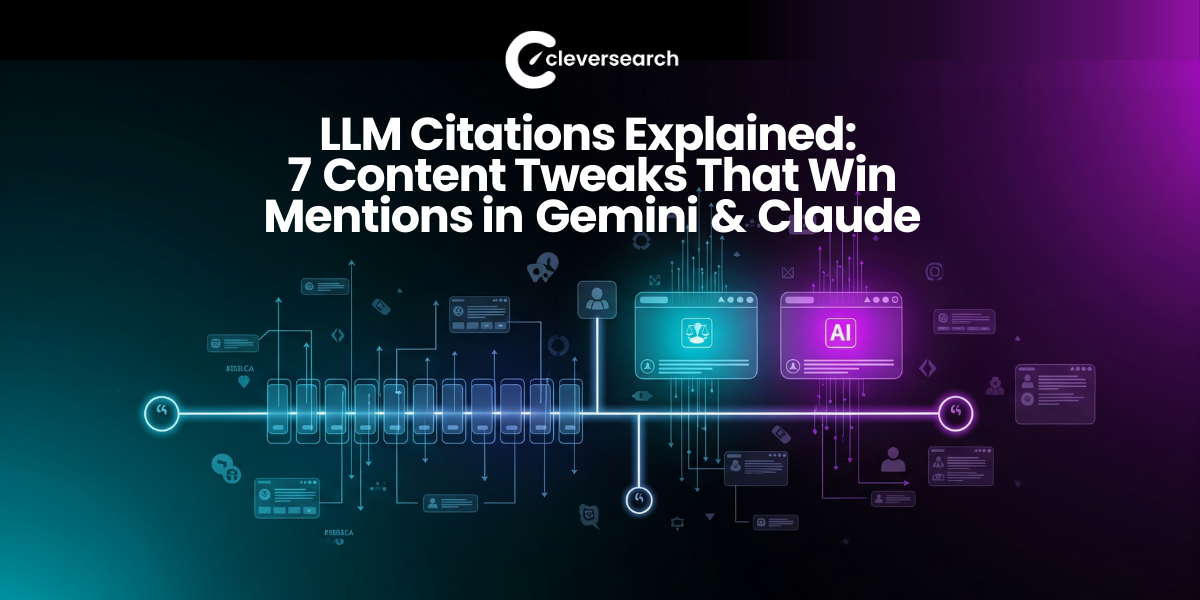LLM Citations Explained: 7 Content Tweaks That Win Mentions in Gemini & Claude

When Google’s Gemini (via AI Overviews) or Anthropic’s Claude 3 answers a user’s question, it now flashes a short list of source links...
When Google’s Gemini (via AI Overviews) or Anthropic’s Claude 3 answers a user’s question, it now flashes a short list of source links. Land in that panel and you inherit instant authority—and a healthy stream of referral clicks. Miss it and you’re digitally ghosted. Both models are already citing millions of pages. Google is rolling AI Overviews from Search into Discover, complete with “Contributing sources” badges while Anthropic just launched a Citations API so every Claude response can point to the exact passage it quoted. So how do you become the site Gemini and Claude love to name‑drop? Start with these seven, research‑backed tweaks.
1. Lead With a 50‑Word Answer
A 7,000‑citation study by Wellows found pages that open with a concise, ≤ 60‑word definition earn 3× more LLM mentions than those that bury the takeaway. Move your summary—or a highlighted “TL;DR”—to the very top.
2. Wrap Key Sections in FAQ & How‑To Schema
Structured data helps AI parsers recognize that your snippet is the answer. Google’s own documentation and independent SEO tests show FAQ/How‑To markup surfaces more often in AI Overviews . Claude’s new API likewise prefers well‑structured fragments when grounding responses.
Action: Add JSON‑LD for FAQs, steps, and product specs on every evergreen page.
3. Add Credible Outbound Links
Gemini and Claude evaluate the company you keep. Pages that reference peer‑reviewed studies, .gov/.edu domains, or recognized industry benchmarks are statistically more “trust‑worthy” in Wellows’ ranking model.
Action: Drop one or two authoritative citations near your main claim.
4. Refresh Content Every 30 Days
Both LLMs weigh recency heavily for factual topics. After AI Overviews expanded in Q2 2025, sites that refreshed stats monthly kept or gained click share, while stale pages lost up to 25 % traffic. Action: Schedule a “freshness sprint” once a month: update data points, screenshots, and publish date.
5. Speed Up & Render Server‑Side
Gemini’s crawler and Claude’s grounding service sometimes skip client‑side JavaScript. Keep critical copy in the first HTML paint and compress heavy assets. SearchEngineLand’s “Chunk, Cite, Clarify, Build” framework stresses fast, chunked content as an AI citation booster.
6. Use Question‑Format H2s
AI Overviews often pull text that directly answers a clearly worded heading (“How does X work?”). Re‑tool sub‑heads into natural‑language questions so models can map query → answer without guesswork.
7. Show Author Credentials
E‑E‑A‑T isn't just for humans. Bios with job titles, degrees, and LinkedIn URLs flag expertise that LLMs can verify. Pages with visible credentials ranked higher in Wellows' citation probability model.
FAQs
What are LLM citations?
LLM citations are source links that AI assistants like ChatGPT, Claude, and Gemini display when answering questions. These citations give credit to the original content and drive referral traffic to cited websites.
How do I get my content cited by LLMs?
Start with a 50-word answer at the top of your page, add FAQ and How-To schema markup, include credible outbound links, refresh content monthly, optimize page speed, use question-format H2s, and display author credentials.
Why are LLM citations important for SEO?
LLM citations increase brand authority, drive qualified referral traffic, and signal to search engines that your content is trustworthy. As AI search grows, citations become as valuable as traditional backlinks.
Which LLMs currently show citations?
Google Gemini (via AI Overviews), ChatGPT (with web search), Claude (via Citations API), Perplexity AI, and Microsoft Copilot all show source citations when answering queries.
How often should I update content for LLM citations?
Update content at least every 30 days. LLMs heavily weigh recency, and pages that refresh stats monthly maintain or gain citation share, while stale pages can lose up to 25% of traffic.
What type of schema markup helps with LLM citations?
FAQ schema, How-To schema, Article schema, and Author schema are most effective. These help AI parsers recognize authoritative content blocks and understand the relationship between questions and answers.
Related Articles
Continue reading about LLM optimization strategies and best practices.
Stay ahead of AI trends
Get the latest insights on LLM optimization delivered to your inbox weekly.
